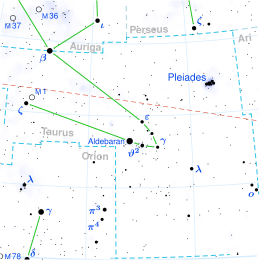Gamma Tauri
| Observation data Epoch J2000 Equinox J2000 |
|
|---|---|
| Constellation | Taurus |
| Right ascension | 04h 19m 47.6037s |
| Declination | +15° 37′ 39.512″ |
| Apparent magnitude (V) | 3.654 |
| Characteristics | |
| Spectral type | G8III |
| U−B color index | +0.84 |
| B−V color index | +0.99 |
| Astrometry | |
| Radial velocity (Rv) | 38.7 ± 0.9 km/s |
| Proper motion (μ) |
RA: +115.29 mas/yr Dec.: -23.86 mas/yr |
| Parallax (π) | 21.17 ± 1.17mas |
| Distance | 154 ± 9 ly (47 ± 3 pc) |
| Absolute magnitude (MV) | 0.22 |
| Details | |
| Mass | 2.70 ± 0.13 M☉ |
| Radius | 13.4 ± 0.2 R☉ |
| Luminosity | 85 L☉ |
| Surface gravity (log g) | 2.58-2.61 cgs |
| Temperature | 4,844 ± 47 K |
| Metallicity [Fe/H] | +0.11 dex |
| Rotation | 253 days |
| Rotational velocity (v sin i) | 4 km/s |
| Age | 430–530 Myr |
| Other designations | |
| Database references | |
| SIMBAD | data |
Gamma Tauri (γ Tau, γ Tauri) is a star in the constellation Taurus and a member of the Hyades star cluster. It has the traditional name Hyadum I, which is Latin for "First Hyad".
Gamma Tauri is a spectral class G8 or K0giant star with an apparent magnitude of +3.65. It is located within about 2.5 parsecs of the center of the Hyades cluster—the nearest open cluster to the Sun. This star has passed through the main sequence phase is now a red clump giant, meaning it is using nuclear fusion of helium at its core to provide energy. Age estimates for Gamma Tauri range from 430 million to 530 million years. By comparison, the age of the Hyades cluster is about 625 million years with an error margin of 50 million years.
Based upon parallax measurements, Gamma Tauri is approximately 154 light years from Earth. The angular diameter of this star has been measured using the CHARA array to 2% accuracy. After correcting for limb darkening, this gives the stellar radius as 13.4 times the radius of the Sun. The star is radiating about 85 times the luminosity of the Sun and has 2.7 times the Sun's mass. With its large size and low projected rotational velocity of 4 km s−1, it takes about 253 days to complete a rotation.
...
Wikipedia

